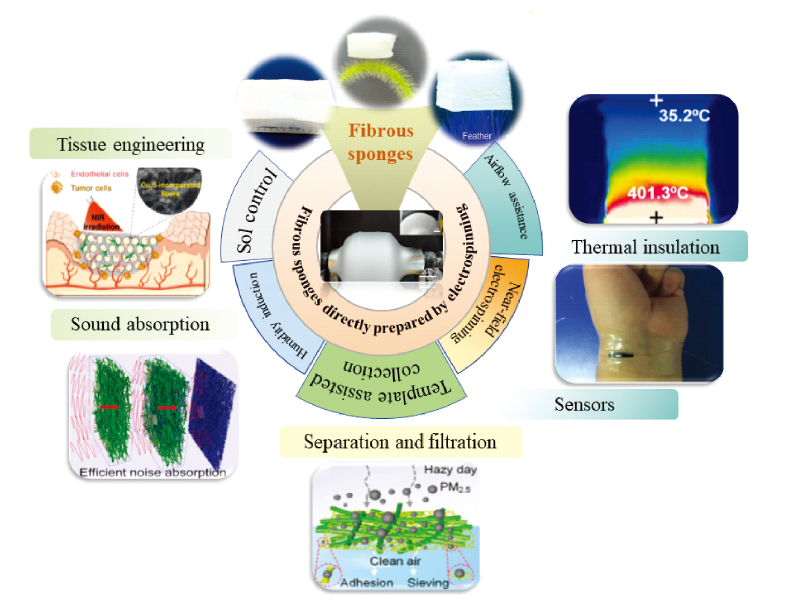 PDF(7293 KB)
PDF(7293 KB)


Preparation and Application of Direct Electrospun Fibrous Sponges
Song Yilong, Zhao Shuang, Li Kunfeng, Fei Zhifang, Chen Guobing, Yang Zichun
Prog Chem ›› 2023, Vol. 35 ›› Issue (11) : 1686-1700.
 PDF(7293 KB)
PDF(7293 KB)
 PDF(7293 KB)
PDF(7293 KB)
Preparation and Application of Direct Electrospun Fibrous Sponges
Electrospun fibrous sponge is a fluffy three-dimensional (3D) material based on one-dimensional fibers. The increase of dimension makes this material have many more prominent advantages than traditional electrospun films, so it has shown great application potential in various fields. With the in-depth study of the three-dimensional structure of electrospinning, it has become a current challenge to obtain stable fibrous sponges directly by electrospinning and improve their performance. In this paper, various new strategies for preparing fibrous sponges by direct electrospinning in recent years are reviewed in detail. Firstly, the mechanism, characteristics and representative research results of different methods are analyzed and summarized. Then the application status of this material in the fields of tissue engineering, environmental governance, safety protection and intelligent equipment is introduced. Finally, the future development trend of electrospinning fibrous sponge is prospected.
1 Introduction
2 Preparation process of direct electrospinning fibrous sponges
2.1 Sol-controlled self-assembly
2.2 Humidity induced phase separation
2.3 Air-assisted electrospinning
2.4 Near-field electrospinning/3D printing
2.5 Template-assisted collection
3 Application of direct electrospinning fibrous sponges
3.1 Tissue engineering
3.2 Sound absorption and noise reduction
3.3 Fire protection and heat insulation
3.4 Filtration and separation
3.5 Sensors
4 Conclusion and outlook

direct electrospinning / three-dimensional structure / fiber curing / tissue engineering / environmental protection
| [1] |
|
| [2] |
|
| [3] |
|
| [4] |
|
| [5] |
|
| [6] |
|
| [7] |
|
| [8] |
|
| [9] |
|
| [10] |
( 成悦, 安琪, 李大伟, 付译鋆, 张伟, 张瑜. 纺织学报, 2021, 42(03):71.)
|
| [11] |
|
| [12] |
|
| [13] |
|
| [14] |
|
| [15] |
|
| [16] |
|
| [17] |
|
| [18] |
|
| [19] |
|
| [20] |
|
| [21] |
|
| [22] |
|
| [23] |
|
| [24] |
|
| [25] |
|
| [26] |
|
| [27] |
|
| [28] |
|
| [29] |
|
| [30] |
|
| [31] |
|
| [32] |
|
| [33] |
|
| [34] |
|
| [35] |
|
| [36] |
|
| [37] |
|
| [38] |
|
| [39] |
|
| [40] |
|
| [41] |
|
| [42] |
|
| [43] |
|
| [44] |
|
| [45] |
|
| [46] |
|
| [47] |
|
| [48] |
|
| [49] |
|
| [50] |
|
| [51] |
|
| [52] |
|
| [53] |
|
| [54] |
|
| [55] |
|
| [56] |
|
| [57] |
|
| [58] |
|
| [59] |
|
| [60] |
|
| [61] |
|
| [62] |
|
| [63] |
|
| [64] |
|
| [65] |
|
| [66] |
|
| [67] |
|
| [68] |
|
| [69] |
|
| [70] |
|
| [71] |
|
| [72] |
|
| [73] |
|
| [74] |
|
| [75] |
|
| [76] |
|
| [77] |
|
| [78] |
|
| [79] |
|
| [80] |
|
| [81] |
|
| [82] |
|
| [83] |
|
| [84] |
( 邹亚玲, 石琳, 周颖, 姚理荣. 产业用纺织品, 2014, 32(9): 22.)
|
| [85] |
|
| [86] |
|
| [87] |
|
| [88] |
|
| [89] |
|
| [90] |
|
| [91] |
|
| [92] |
|
| [93] |
|
| [94] |
|
| [95] |
|
| [96] |
( 刘帅卓, 张颖, 范雷倚, 张骞, 周莹. 材料导报, 2020, 034(017): 17099.)
|
| [97] |
|
| [98] |
|
| [99] |
|
| [100] |
|
| [101] |
|
| [102] |
|
| [103] |
( 杨海贞, 马闯, 魏肃桀, 周泽林, 田征坤. 现代纺织技术, 2023, 31(2): 256.)
|
| [104] |
|
| [105] |
|
| [106] |
|
| [107] |
|
| [108] |
|
| [109] |
|
| [110] |
|
/
| 〈 |
|
〉 |